We all remember that feeling as a new student to Taekwon-Do, our ultimate goal back then was to attain the illustrious black belt. On your first day of training, the first thing you usually learn is how to correctly tie a belt. From there, it’s all history. Every time you put on your dobok and tie that belt, it is comparable to a sacred ritual. There has been a lot of discussion lately about how the belt should be tied, and which way is the “correct way”.
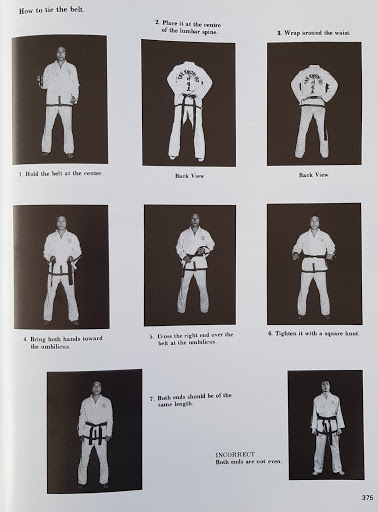
Some of the questions are very clear and easy to answer. As to which side the knot should face, please refer to page 375 of the Condensed Encyclopedia [5th Edition, 1999]. The belt is tied right over left, left over right. This idea, that the right side goes first, aligns with the concept that the right side is more dominant in Taekwon-Do. Korean culture is deeply rooted in hierarchy and many things animate and inanimate have their social order.
The general rule for most things in Taekwon-Do is that the right side is considered ‘dominant’, whereas the left side is treated as ‘submissive’. You turn to your left to tidy up, you step out or step with your left foot from and into ready positions, the junior always stands on the left side in formation, you step forward with the right side first for offensive techniques and your left side first for defensive techniques in linework. I have heard some interesting stories about where the origin of the way the belt is tied in Taekwon-Do came from. Master Rocky Rounthwaite mentioned that during his and Mrs. Rounthwaite’s experience overseas, they met a Korean school teacher who saw an analogy between our dobok and the hanbok. That teacher mentioned that the belt is always tied to the left side because in traditional Korean clothing (hanbok), the tie/belt at the front of a male’s outfit is tied to the left side. Please refer to example of BTS in hanbok below. They are alive in this photo, obviously, and their belts are tied to the left side. Only in death is the belt tied to the right.


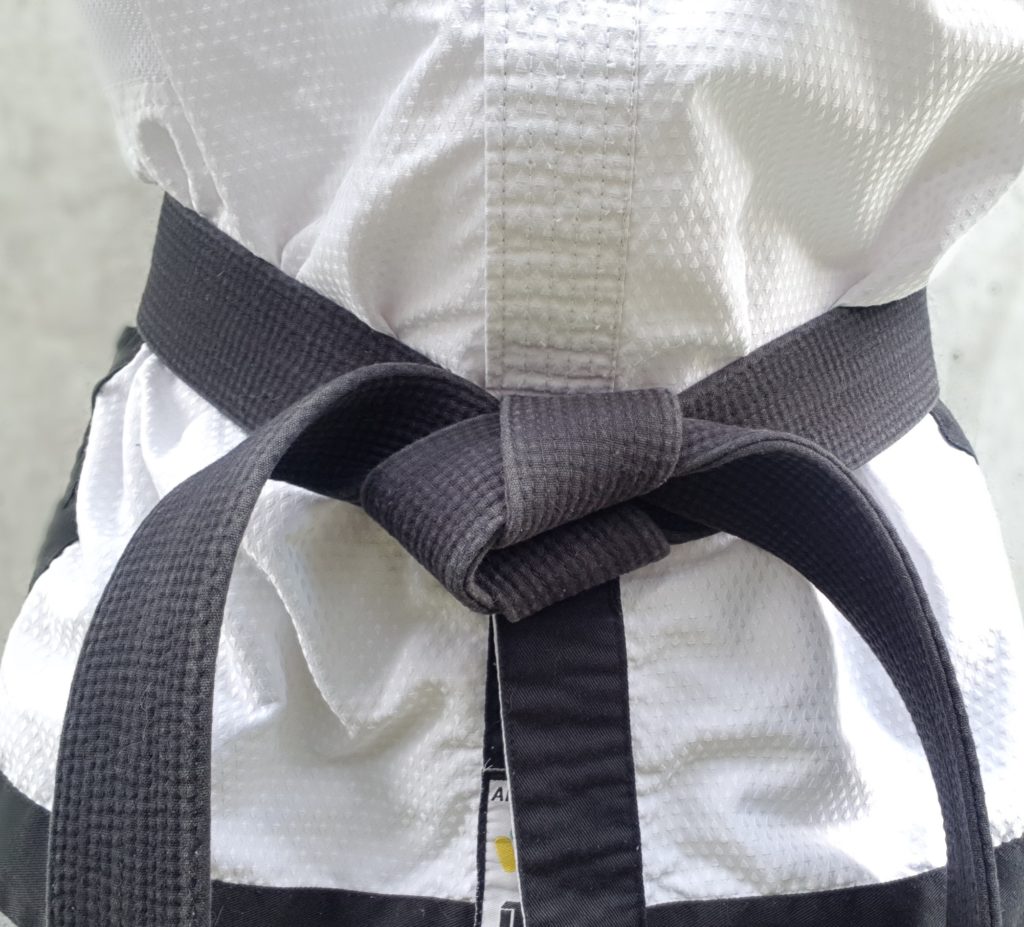
Do I think that this is related to the way we tie our belt in Taekwon-Do? In my honest opinion, I think this is just an interesting coincidence. First of all, the belt on the hanbok is a different style of knot and it does not sit in the middle. Our belts are tied using a reef knot, and it sits at our solar plexus line. It sits neither on the left or the right. Also, if you look closely the knot after death (right side) is more similar that the knot on the left side. Korean people are traditionally rather superstitious. There are many symbols of death, for example the number four, writing any person’s name in the colour red, white chrysanthemum flowers, the cry of a crow, placing your bowl of rice on the right side of your bowl of soup, sticking chopsticks into a bowl of rice or food, to name a few.
The next question is, should your name and rank sit on the left side or the right side?
I started training in ITF Taekwon-Do in 2007, and I was taught it was the right side. I was never told why, nor did I question why. We just did as our instructor told us, and they probably did as their instructor told them. It wasn’t until 2012 when Master Mark Hutton came to New Zealand that he told us that your name and rank should sit on the left side; the same side as your heart. When I enquired as to who taught Master Hutton this tradition his response was simply, “little guy, General Choi was his name”. More recently, Master Rounthwaite informed me that Master Lan also teaches people to tie it with their name on the left side, the same side as the heart. There is no formal instruction or prescription in the Encyclopedia of which side the name and rank sits when tied. When flipping through the Encyclopedia, the name and rank (if and when it can be seen at all in the grainy black and white photos) can be found on both the left and right sides of the belts in the photos. In my opinion, Master Hutton’s source seems to be rather reliable, given it came from the man who founded Taekwon-Do. Also, having the National governing body’s name on the right side, aligns with the concept that the right side is dominant, logical and fixed; whereas the left hand side is subservient, subordinate and compliant. In Korean culture, the collective always comes before the individual. It is the core of our culture. That explains why, in the ‘5 principles of life’ of the Hwarang warriors, being loyal to the king or sovereign is rule number one, whereas family and friends come second and third.
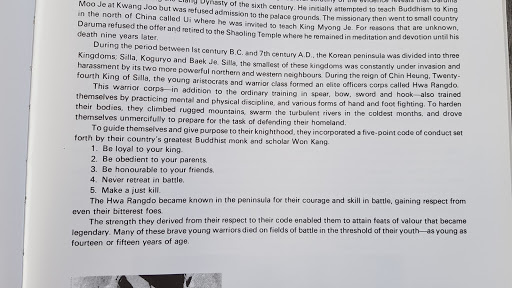
Finally, we delve into how many times should the belt go around the waist? Is it once or twice? Why do we tie the belt around the waist once? What does it symbolise? If we refer to page 373 of the Condensed Encyclopedia. It serves a philosophical and symbolic purpose:

In the same chapter of the Encyclopaedia, it
is mentioned that the uniform that we have has been selected for the purpose of
distinguishing Taekwon-Do’s “technique, philosophical system, spiritual
foundation and rules of competition from other Oriental martial arts”. To be
more precise, to distinguish Taekwon-Do from Japanese martial arts. In Judo and
Karate, the belt is wrapped twice around the waist. Although it is speculation
on my part, one could argue that on July 1st, 1985, the ITF Taekwon-Do belt was
changed to a “once around the waist” belt an effort to separate Taekwon-Do from
its Japanese counterparts. Or dare I say it, its Japanese predecessor. It is a
common misconception that Taekwon-Do is an ancient martial art. It doesn’t take
a lot of research to see that it is in fact a modern martial arts system. ITF
Taekwon-Do is rather transparent in declaring that it is an art that is
influenced by Taek-kyon and Shotokan Karate. What isn’t transparent or easy to
realise however, is that Taekwon-Do is a direct descendent, if not a derivative
of Karate. It is widely known that General Choi detested Taekwon-Do being
referred to as “Korean Karate”. For Taekwon-Do to build its own identity and
for General Choi to promote Taekwon-Do as something uniquely Korean, it needed
to have differences to set it apart from Karate.
The evidence for this is shown in the earliest edition of the Taekwon-Do Encyclopedia, printed in 1959. The book is entirely in Korean and Hanja, with no English translations. In the 1959 edition, the walking stance wasn’t called a walking stance at all. It was called “Jeon-gul sogi” (전굴 서기) instead of “Gunnun sogi”. The L-stance, also did not go by that name. Rather than the “niunja sogi” we know today, it was called “Hu-gul sogi” (후굴 서기).
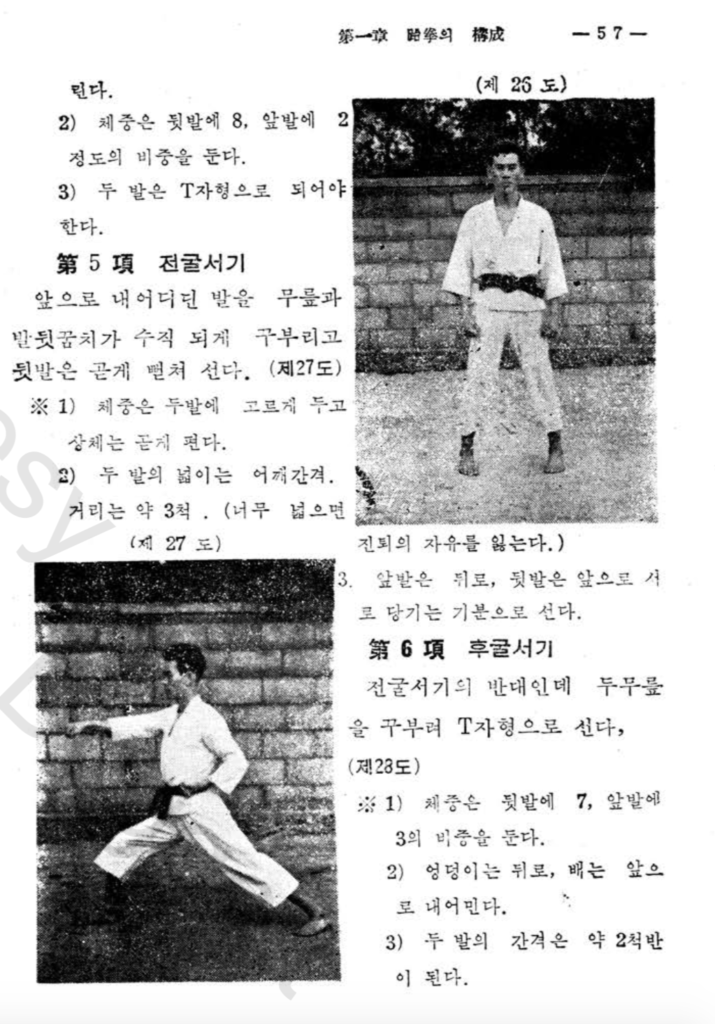
Now, this is where it gets interesting. The Hanja (the Korean version of the Chinese alphabet system) for Jeon-gul (walking stance) is 前屈, which literally means ‘front bent’. The Hanja for Hu-gul (L-stance) is 後屈, which literally means that the rear or ‘back bent’. Now, guess what the Kanji (Japanese version of the Chinese Alphabet system) for almost identical stances in Karate are… you guessed it, exactly the same letters. In Karate, 前屈 is called Zen kutsu, and 後屈 Ko kutsu respectively.
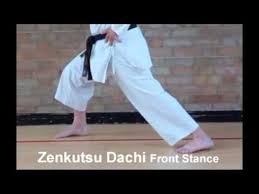
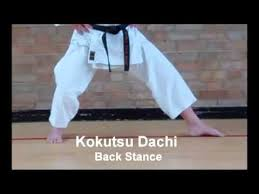
It seems that a lot of the reason behind why certain things are the way they are in Taekwon-Do, is basically just to be different from Karate. For instance; sine wave, the bend in the elbows in parallel stance, two people performing simultaneously in a ring for patterns during competitions and more. If you still aren’t convinced, take a look at this fascinating article regarding the failed blue/”grey” dobok. To me, this quest to change the dobok from the traditional white to contrast itself to Karate is further evidence showing General Choi’s attempts and wishes to prove: “Hey Japanese martial arts, we aren’t copying you. See, we are different”.
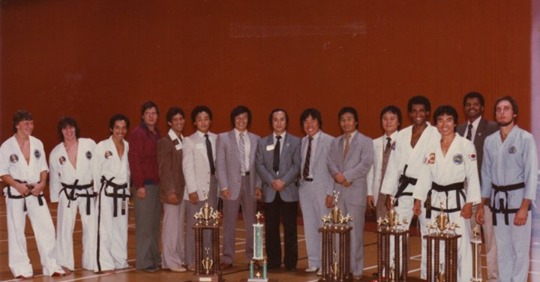
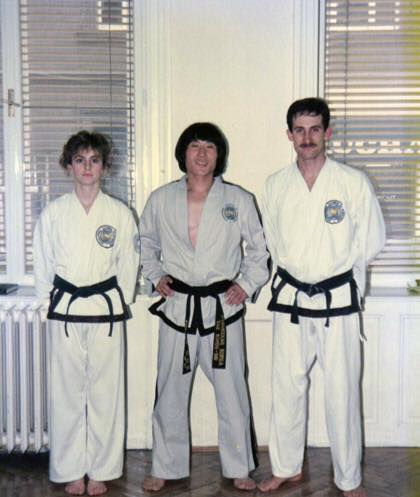

Now, back to the belt. In Karate, Judo and interestingly WT (formerly known as World Taekwondo Federation or WTF), their black belts wrap twice around the waist. Unlike ITF Taekwon-Do, WTF’s main mission wasn’t to be different from Karate. WTF’s objective and goal was to be different from ITF Taekwon-Do.
In the ITF dojang I train at in Seoul, the instructors wear twice around the waist belts. At first I figured that this is because they train and teach both ITF and WT styles. When I asked them about their belts, they very kindly explained that along with my presumption, they also felt that twice-around belts provided more back support and that they prefer it over the once-around. Likewise, I noticed that all the black belts in Japan-ITF wore twice-around belts. When I asked about this, Master Hwang explained that he also preferred the twice around the waist belt. He mentioned that it was likely that Japan-ITF probably started issuing the twice-around belt because it is easier to source good quality black belts that are made in Japan that are twice-around. Once around the waist black belts were probably few and far between. He said that he did once own a once around the waist belt, but he felt it was too flimsy and that it was uncomfortable because it moved around a lot during training. He also felt that the twice-around belt was provided more core support and prevented the dobok top from riding up during training.
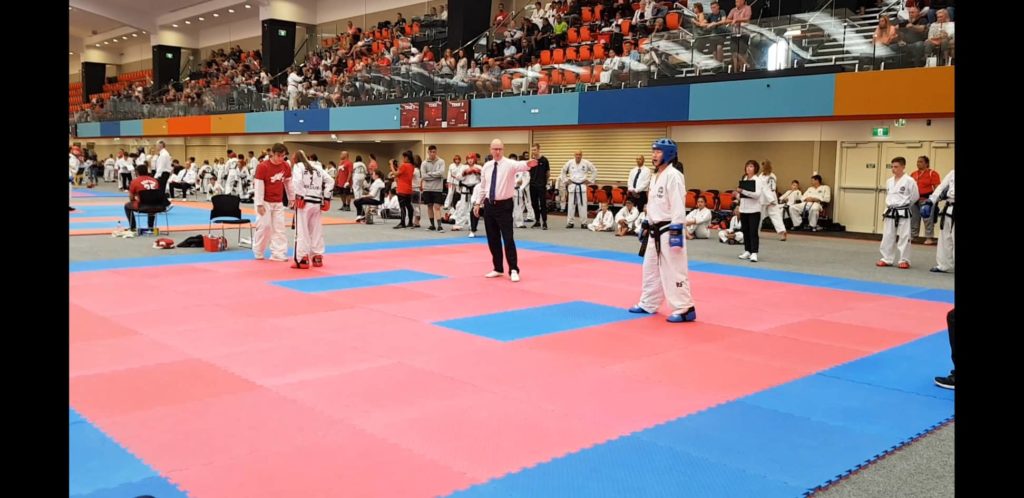
I have never personally worn a belt that goes twice around the waist, but it sounds a lot more practical. My dobok top is constantly riding up, and I have to adjust my uniform regularly. I just thought that’s what happens when you train. I didn’t realise that it was my once-around, philosophical and symbolic belt that was betraying me. The impression that I got from hearing the stories from my instructors in Korea and Japan is that the twice-around belt was more suitable for training, and that the once-around belt was merely symbolic. But I would argue that it is also highly likely that the symbolic reasoning came after the idea of Taekwon-Do having a once around the waist belt. Perhaps the once around the waist belt in Taekwon-Do was conceived in another attempt to be different from its Japanese counterparts.
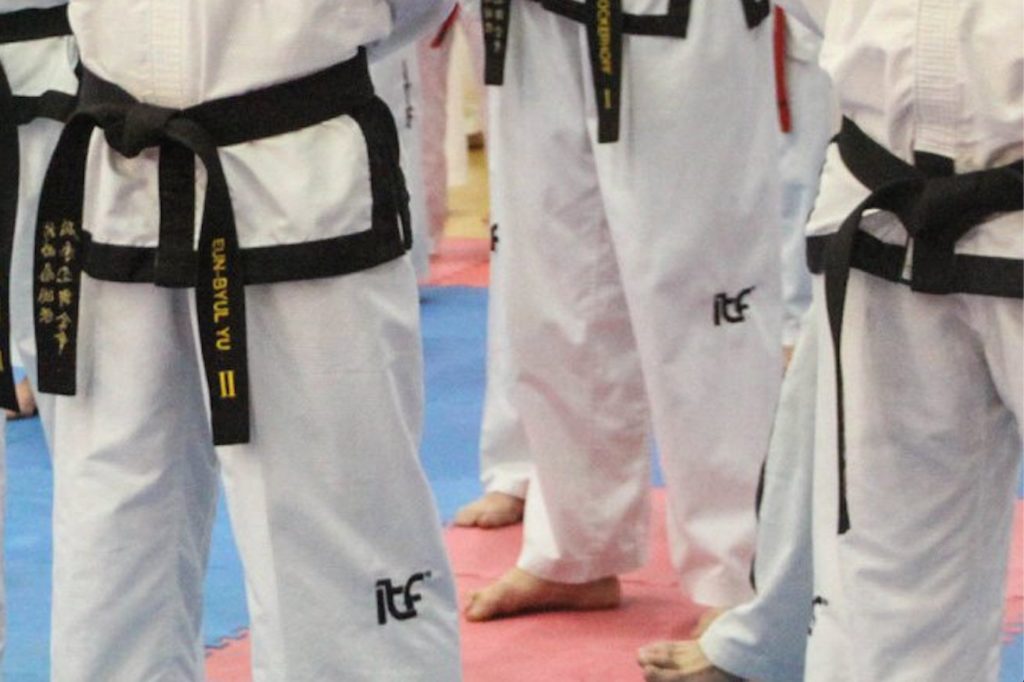
To wrap it up
• The belt is tied right over left, left over right – as explained in the Encyclopedia. No reason as to ‘why’ is given. It is most likely because that is the way it was done in Karate.
• The name is tied on the left side – which is not written in the Encyclopedia, but has been confirmed by those who heard it straight from the General himself. The reason given was that it is because it is the same side as the heart. It may also be because your governing body/nation (the collective) is considered superior to the individual.
• The belt is supposed to be once around the waist – as prescribed in the Encyclopedia. However, according to wearers of both styles, the once-around belt isn’t the most practical or optimal for training. The reason for the once around the waist belt is 1 goal, 1 master, 1 blow for victory. Although, again, realistically it is more likely to be to differentiate itself from Karate.
Irene Yu, 2nd dan
